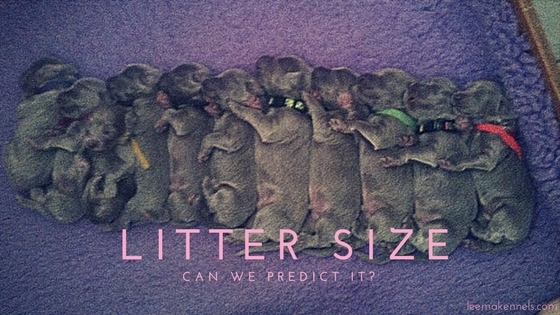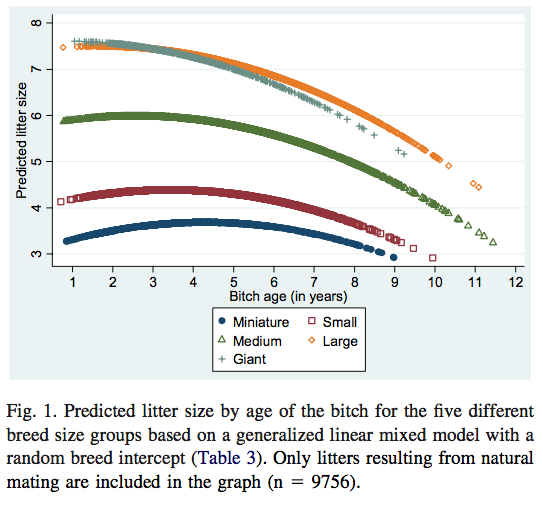
There is an ongoing paucity in the literature surrounding most dog matters, and that means dog knowledge is often based on anecdotes and experience instead of facts and figures. Dog breeding is no exception. Breeders will tell you that they get bigger litters if x, smaller litters if y, that they’ll never mate a bitch if z. While personal experiences can provide case studies, I am interested in much bigger data.
Enter a Norwegian study looking at 10,810 litters.
This study used data held by the Norwegian Kennel Club to look at every litter registered in 2006 and 2007, across 224 breeds. Statistical analysis was then done to determine all the wonderful figures summarised below.
The aim of this study was to determine what actually makes a difference in litter size. (Litter size being the number of puppies born, alive or dead.)
Firstly, an overall average had to be determined. For this data set, the average litter size, considering all breeds, was 5.4 puppies.
For those interested in average litter size by breed: The largest average litter size was in the Rhodesian Ridgeback with an average of 8.9 pups per litter. The Toy Poodle and Pomeranian had the smallest average litter size – 2.4 pups per litter. And the Border Terrier (because I’m biased) had an average litter size of 5.1 pups per litter.
This study found that litter size was influenced by the size of the breed, the method of mating, and the age of the bitch. Litter size was not affected by season of birth, or the number of litters a bitch had had.
Size of the breed
This study examined dogs based on average breed size. They were classed as miniature breeds (<5kgs), small breeds (5-10kgs), medium breeds (10-25kgs), large breeds (25-45kgs), and giant breeds (>45kgs). Bitches were recorded against the average size of a dog for their breed and not specifically on the size of that given bitch.
“When looking at all the … litters…, mean litter size increased with the size of the breed. The mean litter size was 3.5 in miniature breeds, 4.2 in small breeds, 5.7 in medium breeds, 6.9 in large breeds, and 7.1 in giant breeds.”
The feature of larger dog breeds having larger litters is not a new thing – this phenomena is consistent across other studies. But this study is different as it found that it wasn’t just size of the breed that mattered…
Age of the bitch
The first analysis of this data showed no significance with the age of the bitch, however, once breed size was taken into account, there were two trends apparent:
- In small and miniature dogs, young and old bitches had smaller litters than the ages in between.
- In larger breeds, increasing age corresponded with decreasing litter size. (Young bitches of larger breeds produced the largest litters – unlike small and miniature breeds.)
 These results are a little different to other studies, which have shown smaller litter sizes as bitches get older. (As in, the results this study got for larger breeds was seen in all breeds in previous studies.) It could be that smaller sample sizes in other studies may have missed this, or that other studies used larger breeds as their data set instead of small or miniature breeds. One suggestion is that small breeds may not mature as quickly as previously believed, and so they’re not able to reproduce until they reach that mark. (To me, this kind of makes sense – considering small breeds often live longer, then it’s likely that they mature more slowly, too.)
These results are a little different to other studies, which have shown smaller litter sizes as bitches get older. (As in, the results this study got for larger breeds was seen in all breeds in previous studies.) It could be that smaller sample sizes in other studies may have missed this, or that other studies used larger breeds as their data set instead of small or miniature breeds. One suggestion is that small breeds may not mature as quickly as previously believed, and so they’re not able to reproduce until they reach that mark. (To me, this kind of makes sense – considering small breeds often live longer, then it’s likely that they mature more slowly, too.)
Method of mating
Like the age of the bitch, the first analysis on the data didn’t show a significance change in litter size based on mating method. However, when the data set was adjusted for breed, breed size, and age, naturally mated bitches had significantly larger litters than those who had been AIed (either fresh or frozen).
A decrease in mean litter size of 0.4 puppies would be expected for litters conceived with AI with fresh semen and 1.3 for AI with frozen semen, both compared to natural mating.
Things that didn’t matter
The number of litters a bitch had previously didn’t influence the size of her litter. (However, older bitches normally had had more litters – and their age did influence litter size.)
The season the litter was born in did not influence litter size.
Conclusion
Size of the breed, age of the bitch, and the method of mating are three factors that work together in determining litter size. It’s not one thing – it’s all three.
“… the size of the breed, the age of the bitch and the method of mating were found to influence litter size in purebred dogs when controlling for breed, with the size of the breed as the strongest determinant.”
This study is better than past studies in this area for its huge sample size, its variety of breeds, and the fact that it considers all puppies in a litter (not just those registered, as some past studies have done). In this way this study is unique. It is probably a pretty reliable data pool for purebred dogs, too, as 90% of purebred dogs in Norway are registered with their kennel club.
Things to consider regarding the vigour of the results:
- It’s a retrospective study.
- It does not include data from litters where all pups were born dead.
- Calculating mean litter size is hard, because of the percentage made up of small or large breeds. Small breeds are currently popular, so could perhaps pull down the mean litter size seen in this study. Studies done in different countries, with different breeds being popular, are likely to result in different results.
- There is a relatively small sample of bitches who were mated not-naturally in this study, so the results of assisted breedings should be interpreted cautiously, however the results are consistent with previous findings.
- This study only groups dogs by weight – not by body shape. This might yield differences. (A neapolitan mastiff is really different to a greyhound.) And they group them by weight average of breed, not the weight of the individual bitch
- This study looked at only two years and the researchers wonder if there might have been more variation in season of birth if there was more time taken into consideration.
In conclusion: Based on this study, breed size is the strongest determinant for litter size in a dog. The age of the bitch and the method of mating were also significant predictors of litter size. These three things interact, making litter size predictions difficult!
Acknowledgements:
Borge, KS, Tonnessen, R, Nodtvedt, A, & Indrebo, A 2011, “Litter size at birth in purebred dogs – A retrospective study of 224 Breeds”, Theriogenology, 75, 911-919.
Thank-you to Waldwiese Kennels for the cover image – a litter of longhair weimaraner puppies.
